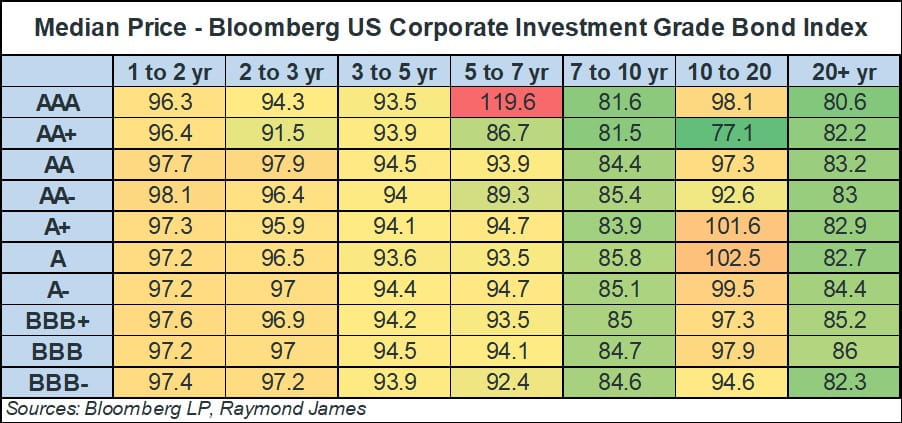by Drew O'Neil, Fixed Income Strategist, Raymond James
Drew O’Neil discusses fixed income market conditions and offers insight for bond investors.
Ask yourself why you are investing in fixed income. Not why do most people invest in fixed income or how do most people utilize fixed income in their portfolio, but why are YOU investing in fixed income? Identifying the why will guide you to what characteristics to seek when buying bonds. Is a high level of cash flow a priority? You will likely want to focus on higher coupon bonds that will provide the cash flow you seek. Is eliminating credit risk of utmost importance? Look to a product with government backing like a US Treasuries or FDIC-insured CDs. In the current corporate bond landscape, for investors whose “why” isn’t to maximize current cash flow, an opportunity has presented itself that hasn’t been readily available in recent memory: buying corporate bonds at a deeply discounted prices.
Why is this opportunity available? Over the course of most of 2019 through 2021, interest rates were at very low levels by historical standards. As a result of the low yield environment, most of the bonds issued in this timeframe were issued with very low coupons. Last year, yields rose dramatically which is how we arrived at where we are today, where yields available are at levels we haven’t seen in 10-15 years across some parts of the market. Bond math 101 tells us that as yields rise, prices fall. This happens because a bond with a fixed low coupon will have to be sold at a lower price in order to compete with newly issued bonds that have higher coupons. Most of the low-coupon bonds that were issued over the past few years are now selling at discounted prices.
Why might deeply discounted bonds be appealing? And to whom?
- They require a smaller principal outlay relative to face value. If a bond is priced at 80, purchasing $100,000 in face value (maturity value) will only cost ~$80,000.
- The maturity value is known, so barring a default, there is a known appreciation value at the time of purchase. While the price of the bond will fluctuate based on market conditions, it will gravitate towards par over time.
- A low coupon reduces the probability that a bond will get called. Many intermediate and long maturity bonds were issued with low coupons and near-term call dates over the past few years. Purchasing these low-coupon/deep-discount bonds lessens the probability of a call (and corresponding reinvestment risk) compared with higher coupon bonds with similar call dates.
- Given the rapid rise in yields, deep discount bonds are prevalent. Casting as wide a net as possible when searching for investment opportunities increases the likelihood of finding unique pockets of value.
- For investments when the goal is capital preservation and a known outcome is still desired, deeply discounted bonds can be an ideal fit. For example:
- Investments in qualified accounts where the investor is not currently pulling from the account.
- Similar to how some investors utilize zero-coupon municipals, investors who are looking to fund a future liability (buy that beach house in 10 years or pay for a grandkid’s college) might find deep discount corporate bonds attractive, given the lower principal required upfront and the known value (barring a default) at maturity. Zero coupon municipal bonds can be somewhat difficult to find in the current market while low coupon corporate bonds are readily available.
The low coupons may possess a higher duration which means that these bonds will be more sensitive to changes in interest rates. For buy-and-hold investors who plan on holding until maturity, this is likely not relevant (neither a positive nor a negative) as bonds will not be sold at market prices. For investors who are concerned with interim price movement (total return investors), the relatively higher durations will be beneficial in a falling rate environment and counterproductive in a rising rate environment.
Where does this opportunity exist? The chart below shows the median price of bonds that make up the Bloomberg Investment Grade Corporate Bond Index. The applied heat map highlights where these deeply discounted bonds can be found (the darker the green, the lower the median price). The 7 to 10 year maturity range or long-dated (20+ year maturity) bonds are primarily where these deeply discounted bonds can be found. Given the availability of bonds in the 7 to 10 year window combined with the relatively shorter maturities compared with 20+ year bonds (meaning less duration risk and exposure to credit risk for a shorter period of time), the 7 to 10 year range likely makes the most sense for most investors although the opportunity does exist out longer where appropriate for the specific investor.
This strategy may not be appropriate for every investor but for investors who meet the criteria and/or are interested in the characteristics outlined above, the opportunity is presenting itself. If interest rates continue to move lower, the window of opportunity might close, so reach out to your financial advisor today to see if this is a strategy that could benefit your portfolio and long-term financial goals.
The author of this material is a Trader in the Fixed Income Department of Raymond James & Associates (RJA), and is not an Analyst. Any opinions expressed may differ from opinions expressed by other departments of RJA, including our Equity Research Department, and are subject to change without notice. The data and information contained herein was obtained from sources considered to be reliable, but RJA does not guarantee its accuracy and/or completeness. Neither the information nor any opinions expressed constitute a solicitation for the purchase or sale of any security referred to herein. This material may include analysis of sectors, securities and/or derivatives that RJA may have positions, long or short, held proprietarily. RJA or its affiliates may execute transactions which may not be consistent with the report’s conclusions. RJA may also have performed investment banking services for the issuers of such securities. Investors should discuss the risks inherent in bonds with their Raymond James Financial Advisor. Risks include, but are not limited to, changes in interest rates, liquidity, credit quality, volatility, and duration. Past performance is no assurance of future results.
Investment products are: not deposits, not FDIC/NCUA insured, not insured by any government agency, not bank guaranteed, subject to risk and may lose value.
Copyright © Raymond James

















